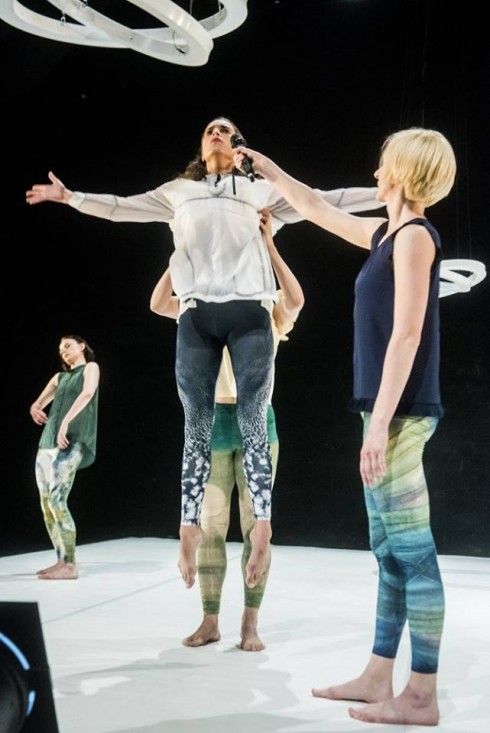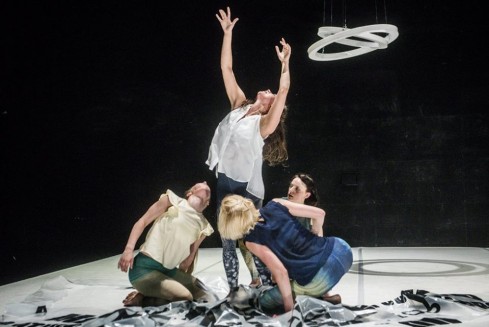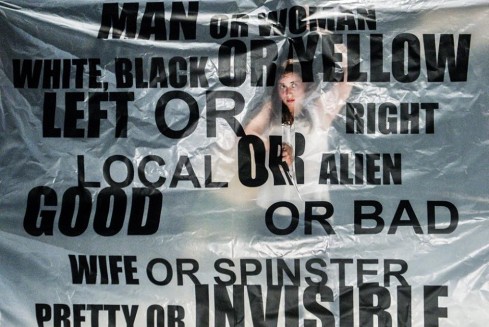The following is a collage of sentences about the performance Agonija written by participants of a dance criticism seminar (Greta Bernotaitė, Ingrida Gerbutavičiūtė, Bradley Castelli, Božena Gudalevič, Rasa Birietė). The seminar took place on December 9-10, 2017 at the Arts Printing House in Vilnius.
Being human often involves violence and fighting for the right to become one. Can you dance, jump, spin around, jump again, go into a deep plié and do a handstand without losing your breath? The dancers of Vytis Jankauskas Dance Company (Sigita Juraškaitė, Giedre Kirkilyte, Giedre Stankevičiūte) can. Unless it is a game to hold one’s breath, as it was for Greta Grinevičiūtė.

The performance Agonija is like a game about the physical possibilities of human being and the breath. It is a game without an answer – why can’t an individual’s development and search for answers about the meaning of life proceed without agony? A stronger effect is achieved when the main character holds her breath. The sound of the dancer wheezing and barely able to gasp for air makes it hard to breath as an observer. The terms sympathy and empathy are too often misunderstood to be synonyms. If you’re interested in seeing if and how to deal with agony, and are ready to exhaust at least a night’s supply of empathy on an exceptional group of artists, then Agonija awaits you. One thing we all have in common is the fact that we are human, and that the subtle differences that set us apart are still influenced by similar emotions and experiences, like agony. When we are in agony, thoughts look at us like an object of experimentation.

The main performance narrative is rhythm. Black drums in the middle of the stage. An intriguing percussion set invites the audience to imagine how the lid of the big pot or the plastic bucket would sound. In this performance, you not only meet rough and manipulative but also soft and balanced energy, jazz and electronic music with live percussion sounds, and get to see colorful stitches of fashion. The part when the drums are played is a bit too obvious, while the dance incorporating loud breathing into a microphone, violence, repetition, structure and improvised movements makes Agonija an interesting performative dance piece. The chosen music tracks and lighting design collaborate well with the dance.

Three rounded luminaries/lamps, white lights mildly similar to those in hospitals or to those found in a modern flat or house. The sculpture-like luminaries create interesting lights and shadows on the ground. This performance is broad enough to allow for interpretation without taking itself too seriously and being rendered overtly artsy-fartsy.
Greta Grinkevičiūtė is dressed up in monochrome. The other three wear green patterned tights and colorful tops. The uncolored one gets bullied by the others, who are trying to make her play the drums. The contemporary dance performance piece depicts a character up to her neck in anguish. The torment of the main character is palpable.
Small heart disorders, a disturbed natural flow of life. It looks like the dancers are looking for concentration, equilibrium, and an education in self-awareness. They possess excellent contemporary dance skills, but physical technicality is not over-showcased. The human relationship between the dancers becomes more important than high jumps and other tricks. In terms of movement, the four artists blurred the lines between grace and what can be described as knee jerk reactions.

During the last part the music becomes calmer and softer, almost like light breath playing in the dancers’ blouses. The demons both breathing life into her (Greta Grinkevičiūtė) and sucking it back out was mesmerizing.
In the final part Giedrė Stankevičiūtė and Giedrė Jankauskienė are holding the printed plastic in such a representative way as if they were selling a BMW dressed in bikinis. The text speaks about tolerance in politics, gender, nationality <…> issues.Words like “men or women, local or alien, left or right <…> blah blah blah”. Labels are not important here. Nothing is important. The plastic is torn apart slowly, without aggression. It is cut into squares with scissors.

Vytis Jankauskas manages to talk in his own language about the difficult situations in one’s life and the pressures contemporary society puts on the individual, who searches for freedom and for a way to be themself. Dance is not blind to the human condition and can definitely serve as a medium for social commentary.
Foto: Dmitrijus Matvejevas